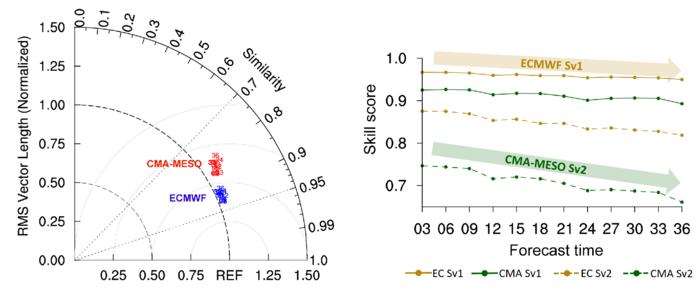Vector winds serve as a fundamental mechanism in the development and sustenance of various convective weather phenomena, notably squall lines and typhoons. Additionally, they play a crucial role in optimizing the harnessing of wind energy. The scenario surrounding weather forecasting relies heavily on the models implemented by the China Meteorological Administration (CMA-MESO) and the European Center for Medium-Range Weather Forecasting (ECMWF). Despite their widespread utilization, there appears to be a significant gap in understanding how accurately these models forecast vector winds, an essential component in the meteorological equations governing weather patterns.
Recent investigations have indicated that the simulation of vector winds by these forecasting models often leads to discrepancies and uncertainties. Specifically, the traditional approach of breaking down wind predictions into zonal and meridional components—or simply wind speed and direction—has historically obscured the actual effectiveness of the forecasted wind fields. Such bifurcation may contribute to an array of forecasting challenges, particularly when evaluating the performance of these models in specific geographical contexts, such as the eastern coast of China.
In a notable study published in the journal "Atmospheric and Oceanic Science Letters," researchers from China embarked on a comprehensive evaluation of the vector wind fields predicted by the CMA-MESO and ECMWF models in the context of East China during 2022. Their rigorous analysis utilized a vector field evaluation method that transcends traditional wind speed considerations, ultimately providing a deeper insight into modeling efficacy.
Findings from the research were illuminating, revealing that the ECMWF model outperformed its CMA-MESO counterpart regarding the accurate prediction of the spatial distribution and intensity of vector wind fields in the region. While both models exhibited a tendency to overestimate wind speeds, the CMA-MESO model demonstrated a more pronounced propensity for overestimation, thus contributing to greater forecasting inaccuracy. This disparity raises critical questions about the reliability of meteorological predictions and emphasizes the need for continuous refinement of modeling techniques.
Dr. Fang Huang, a prominent researcher affiliated with the Jiangsu Provincial Meteorological Service Center in China, outlined the peculiarities of forecasting efficacy observed in both models. He noted a concerning trend: as the forecasting time increased, the skill associated with vector wind predictions deteriorated. Furthermore, the decline in accuracy was notably pronounced in the CMA-MESO model, characterized by both rapid decreases and greater variability. Such fluctuations in forecasting accuracy underscore the inherent volatility in weather prediction methodologies and highlight the necessity for enhanced model sophistication.
This analysis of vector winds serves not only a meteorological relevance but also extends to a pragmatic understanding of wind energy potential. The fluctuations inherent in wind fields are critical indicators of atmospheric behavior, which ultimately affects the stability of wind energy generation. As society increasingly pivots towards renewable energy, understanding and resolving these variabilities becomes imperative to harnessing wind power effectively.
Expanding their research scope, the scientific team also delved into the temporal variability inherent within the vector wind fields. Their findings illustrated marked differences between land and ocean influences, with the ocean exhibiting greater variabilities than the land. Additionally, they noted a geographical pattern where northern regions displayed more significant wind variability in comparison to southern counterparts. Intriguingly, the CMA-MESO model was observed to overestimate the amplitude of this variability, leading to questions about the reliability of its predictions in wind energy potential.
Consequently, this overestimation by the CMA-MESO model could introduce significant uncertainties in wind energy forecasts, making it critical for stakeholders reliant on accurate data to reconsider their modeling approaches. As wind energy continues to garner importance in the global energy matrix, optimizing forecasts is not merely an academic exercise but a matter of practical concern.
In light of their findings, the researchers suggest that evaluating numerical weather prediction models’ wind fields through the lens of vector fields can yield meaningful insights into their operational efficacy. By recognizing and addressing the shortcomings of existing meteorological models, further refinements can be made, ultimately leading to more reliable weather predictions and enhanced understanding of climate dynamics.
This original investigation has far-reaching implications, particularly for energy sectors transitioning towards sustainability. As accuracy in weather modeling becomes increasingly intertwined with renewable energy resources, the value of these scientific inquiries cannot be overstated. The meticulous identification of the strengths and weaknesses within existing models stands poised to bridge gaps in wind forecasting reliability and establish a pathway for future advancements.
In conclusion, evaluating the vector wind capabilities of renowned numerical weather forecasting models brings to light critical insights that go beyond theoretical modeling. By comprehensively understanding these predictive strengths and weaknesses, improvements can be enacted, fostering a gradual transformation in meteorological forecasting practices. This ongoing dialogue between climate science and energy viability represents an essential frontier for future research and investment.
Through rigorous analysis and diligent inquiry, this study presents a clarion call for advancement, urging both the meteorological community and energy policymakers to embrace a more nuanced understanding of wind dynamics.
Subject of Research: Evaluation of vector wind forecasts by CMA-MESO and ECMWF models in East China.
Article Title: Evaluating vector winds over eastern China in 2022 predicted by the CMA-MESO model and ECMWF forecast.
News Publication Date: 24-Oct-2024.
Web References: DOI
References: Not specified.
Image Credits: Fang Huang.
Keywords: Vector winds, weather forecasting, CMA-MESO, ECMWF, wind energy, meteorological modeling, atmospheric dynamics.




